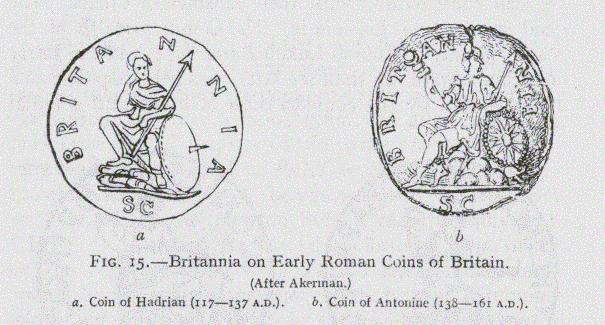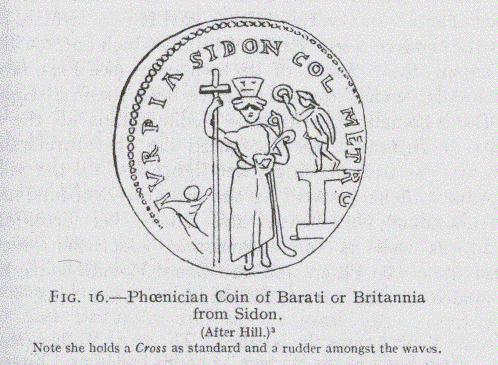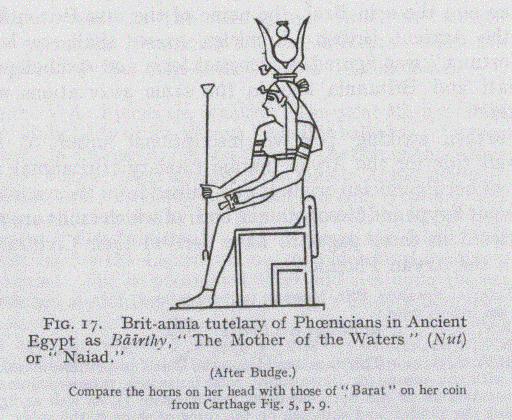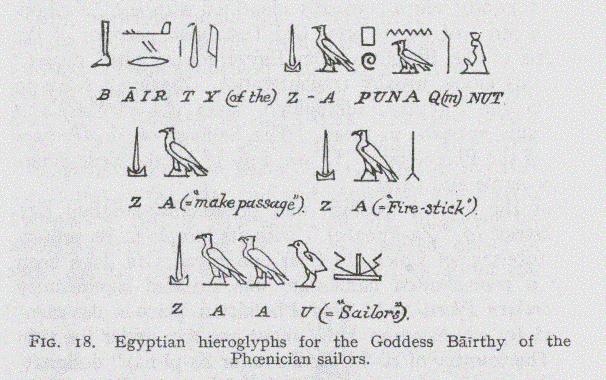
FIG. 13. Phoenician Patronymic titles "Parat" and "Prydi" or "Prudi" on Phoenician tombstones in Sardinia.3
Disclosing Aryan Phoenician Origin of the tutelary Britannia and of her form and emblems in Art.
"And King Barat gave his name to the Dynastic Race of which he was the founder; and so it is from him that the fame of that Dynastic, People hath spread so wide."-Maha Barata.1
"Like a Father's Name, men love to call their names."-Rig Veda.2
THE title of "Prat" or "Prwt," borne by our colonizing Phoenician Cassi prince on his British monument at Newton, is now seen to be clearly a dialectic form of the patronymic title "Barat" or "Brihat" used by the Aryan Phoenicians as recorded in the Indian epics and in the Vedic Hymns, as cited in the heading, the Phoenicians being, as we have seen, a chief branch of the Barats, or the descendants of King Barat, and they are systematically called "Barat" in the Indian epics and Vedas. And this Aryan Phoenician title of "Barat" or "Brihat" is now disclosed to be the Phoenician source of our modern titles "Brit-on," "Brit-ain," and "Brit-ish."
[As explaining the various spellings of this name "Barat," it is to be noted that the interchange of the labials B and P is a not uncommon dialectic change in all languages, and it is especially frequent at the present day in the highlands of Scotland and in Wales. It already occurs to some extent even in Sumerian; and in the Indian Vedas and epics, this particular word "Barat" is also sometimes spelt Pritu or Prithu and
52
Brihat (as seen in the heading on p. 1) and Brihad.1 This latter form, whilst thus equating with the Cymric Welsh "Pryd-ain" for "Brit-on," also illustrates the further common dialectic interchange of the dentals t and d, in the spelling of this name. It also shows that the early pronunciation of this name varied considerably, and that the i came early into "Brit" or "Briton."]
The Cassi kinsmen of our Cassi Phoenician Briton in Babylonia and Syria-Phoenicia also used this patronym of Barat freely as a personal name or title, in the various dialectic forms of Barata, Biriitum, Paratum, Baruti, Burattu, Burta, Biriidia, Piradi, and Piritum.2
The later Phoenicians also, whilst spelling this title "Barat" on their coins (as we have seen in Fig. 5, p. 9) that is, in its full orthographic form, also spelt it, I find, with

an initial P as "PRT," thus giving practically the identical form on the Newton Stone; and they also spelt it as "Prydi," or "Prudi," thus giving the same form as in the Cymric. Thus, for example, in the old Phoenician grave stones in Sardinia, an ancient colony of the Phoenicians, I find that, in two out of a series of eight tombstones, the Phoenician persons are so designated (see Fig. 13); and that in a script, closely allied to that of the Newton Stone, but written in the reversed direction with reversed letters, presumably, as already noted, for the information of a Semitic population accustomed to read their writing backwards like the Hebrews. And it is further significant that the name by which these
Phoenicians call their graves, "Khabr," appears to be essentially the same as the Gothic term "Kubl," applied in Runic inscriptions to the funereal barrows of the Goths-the liquid semi-vowels r and l being freely interchangeable, as in Hal for Harry, coronel for colonel and the cockney "arf" for "half."
This Phoenician spelling of the Barat title as PRT, in which the short vowels are unexpressed, as usual in Phoenician, just as they are similarly unexpressed in our Newton Stone inscription, and in the Indo-Aryan, Pali and Sanskrit, and in Hebrew, etc., thus gives a little variety in its reading. It may read either PaRaT or PaRT or PRaT, thus giving all the three forms of Parat (the equivalent of Barat), or Part, or Prat, as in the Newton Stone, and the equivalent of "Brit." In regard to this latter form of Prat or Prwt on the Newton Stone, we shall find later that the famous Ionian navigating geographer Pytheas who circumnavigated and surveyed Britain as far as Shetland about the middle of the fourth century B.C., that is, about the time of our Newton Stone inscription, also spelt the name of Britain with an initial P, calling the British Isles "Pretanikai"; and "Pret-anoi" continued to be the name used by Ptolemy and other Greek writers for Britain and the Britons.
But, although the later Phoenicians of Cilicia, like those of Sardinia above-noted, whilst using P for B, in calling their chief city-port Tarsus, by the name of "Parth-enia" or "Place of the Parths," their remnant or their Aryanized and Phoenicianized successors thereabouts, so late as about the third century A.D., nevertheless continued to call themselves "Barats," as seen in their coin here figured. (Fig. 14).
The first of these coins tells us that it was a coin of the "Barats of Lycaonia," which was the ultramontane portion of Cilicia to the north of the Taurus, and contained, besides the capital city of Iconium (the modern Turkish capital Konia, a city which was visited more than once by St. Paul)1, also the ancient city of Barata, to the south of which (at Heraclea, the modern Ivriz), on the ancient Hittite highway from
Ephesus and Troy to Tarsus and the Cilician Gates of the Taurus, are famous herculean Hittite sculptures and hieroglyphs, resembling those on Briton coins (see Fig. 62 in Chapter XXII.). The Lycaonians in the Roman period were still confederated with their kinsmen of Cilicia. The legend stamped on this coin is "The Commonwealth of the Lycaon Baratas" (Koinon Lukao Barateon); and the Early Phoenician empire, we shall see later, was held together as a commonwealth by the confederation of home and colonial city-states.

These coins, with others of the same type elsewhere, are of immense historical importance for recovering the lost history of the Britons in Britain and in their earlier homeland, as they now disclose the hitherto unknown origin of the modern British marine tutelary "Britannia," and prove her to be of Hitto-Phoenician origin.
Usually the head only of this goddess is figured on Phoenician coins, and it is of a fine Aryan and non-Semitic type; see for example the Phoenician "Barat" coin from Carthage (Fig. 5, p. 9), and Phoenician coins generally. In these coins of Lycaonia the general resemblance to Britannia
will be noticed-Britannia hitherto being supposed to have been first invented by the Early Romans in Britain in the 2nd century A.D. (see Fig. 15) in practically the identical form still surviving on our modern British penny.

In these Barat Lycaonian coins Barati is seated in the pose of Britannia, in the first upon a rock, and in the second on a chair (of a ship) amidst the waves, the latter being personified by a semi-submerged water-nymph, as was the conventional method of representing rivers and the sea, after the nereid model of the Lycians, in the Roman art of the period to which this coin belongs. She holds a cornucopia or horn of plenty and in her right hand, in one of the coins, an object which may be a sceptre, as is figured in her representation on many of these coins; and in the other she holds the tiller of a rudder, indicating her marine tutelarship; and beside her chair on board ship is the shield-like Sun Cross or St. George's Cross within the Sun's disc, designating her to be of the solar cult. This latter emblem is now seen to be the origin of the shield bearing the Union Jack which is figured in the modern representations of Britannia, but which cannot date earlier than the Union of England and Scotland in 1606 AD., and was previously presumably the St. George's Red Cross or the rayed Cross or the rayed Sun itself, as in these coins. In other coins of Cilicia, Lycaonia, Phoenicia and other Phoenician
colonies she sometimes holds a sceptre1 or a standard Cross (see Fig. 16), or a caduceus2 which latter ensigns of authority were presumably the source of the Neptune trident now given to her in her modern British representation. And she sometimes carries a torch4 as in the representation of the "Sun-god" Mithra, the torch of the Sun, which explains the lighthouse figured beside Britannia on the old pennies

This beneficent marine and earth tutelary goddess of Good Fortune has not usually her name stamped on the coins bearing her effigy, and has been surmised by modern numismatists to be the late Greek goddess of Fortune (Tyche), the "Fortuna" of the Romans, a goddess unknown to Homer5, and who first appears in Greek classics in the odes of Pindar (about 490 B.C.). In this regard it is interesting to note that the first traditional statue of this goddess of Fortune (or Tyche) is reported to have been made for the people of
Smyrna1-that is, an ancient Hittite seaport of the AEgean with rock-cut prehistoric Hittite hieroglyphs in the neighbourhood.
Her proper name is now disclosed by the Vedic hymns of the Eastern branch of the Aryan Barats to have been Barati; meaning "Belonging to the Barats." She is also called therein "Brihad-the Divine" (Brihad-diva); and she seems identical with Pritvi or "Mother Earth." Her especial abode was on the "Saras-vati River," which, I find, was the modern Sarus River of Cilicia which entered the sea at Tarsus, the "Tarz" of its own coins (see Figs. later) or Parth-enia, which appears to have been the first seaport of the Barat homeland. In these Vedic hymns all the attributes of Britannia are accounted for; her tutelarship of the waters and of ships, her lighthouse on the sea, her Neptune trident (as well as the origin of Neptune himself and his name), her helmet and shield, her Cross on the shield, as well as the cornucopia, which she sometimes bears upon the Phoenician and Greco-Roman coins, taking the place of the corn-stalk on the Briton coins.
In the Vedic hymns she is called "The great Mother (Mahi)"2 and "Holy Lady of the Waters"3 and is hailed as "First-made mother" in a hymn to her son "Napat the Son of the Waters"4 who has a horse [thus disclosing the remote Aryan origin of the the name and personality of the old Sea-god, Neptune, and his horses, and accounting for Neptune's trident in her hands.] She is a "Fire-Priestess"5 and "shows the Light"6 [thus accounting for the Lighthouse on the older British coins with Britannia]. She is personified Fire7 and sits upon the sacred Fires8 [thus accounting for the St. George's Cross which, we shall find later, symbolizes Fire of the Sun]. She is associated with the twin horsemen of the Sun (Aswin or Dioscorides), represented on the Briton coins,9 and coins of Syracuse (an ancient Phoenician
colony)1, etc. She is "Lady of Health," and "The Food-bestower"2 [thus accounting for the cornucopia and heads of corn on the coins]. She "shelters, protects and aids her Barat votaries"3 [thus accounting for the "Saviour" (soter) title of the Greco-Roman goddess of Fortune], and she "bestows good mornings."4 She is "slayer of the leviathan brutes (vritra),"5 [thus accounting for her warrior's helmet of Hittite pattern and shield]; and she "speeds forth our cars."6
The name "Fortuna," by which the Romans called this Barat tutelary goddess of Good Fortune,7 as well as the English word "Fortune," now appear to be coined from her title of "Barati"-the letter F being interchangeable dialectically with P and B, as we have seen in the Egyptian "Fenkha for "Phoenic" and in the Greek Pyr for Fire, and P with B; and its affix una or "one" is now disclosed to be derived from the Hitto-Sumerian ana ("one"), thus giving the title of "The one of Barats" (or "Fortune"). The o came in dialectically like the w in Prwt on the Newton Stone and the u in Brut, the name of the first Briton king in the Ancient British Chronicles, as we shall see later. "Fortuna" was figured in identical form and symbols with Barati and Britannia and in the same associations with water.8
Further striking positive inscriptional proof of this Barati title for the Aryan marine tutelary (Britannia) and also of her Phoenician origin is now gained from the records of Ancient Egypt and Mesopotamia, both of which lands are now disclosed in these pages to have derived their Civilization from the Aryan Phoenicians.
Amongst the deities of Ancient Egypt is a protective goddess named, "Bairthy,1 goddess of the Water," whose name and functions are thus seen to be precisely those of the Aryan tutelary Barati (or Britannia). She is one of several deities in the Egyptian pantheon who are called by Egyptologists "foreign," or imported from Syria and elsewhere, notwithstanding that several of the leading "indigenous Egyptian" deities, such as the Sun-god Horus, Osiris and Isis are also admittedly imported, also from "Syria" in certain traditions; and, according to Egyptian myth, this particular "Goddess of the Waters" (Bairthy) herself was "the mother" of the above-cited triad. 2 And under her title, in the inscription below, as "Goddess of the Waters," she is also of the solar cult and supports "the Boat of the Sun-god."3 She is represented in art, moreover, by the ancient Egyptians (see Fig. 17) as a seated queen in the same general form and pose as in the Asia Minor coins of

Barati (Fig.14, p. 55), and bearing a similar pitcher on her head (symbolizing the Waters) and holding a long spearlike sceptre and the handled Cross-sceptre, corresponding to the Cross on the throne of Barati and on the shield of Britannia.
She is further entitled "The Lady Protector of Zapuna,"1 a seaport city which is usually identified with the "Zephon-by-the-sea" of the Hebrew Old Testament account of the exodus of the Israelites from Egypt to the Sinai desert.2 But this name, usually transliterated "Zapuna," reads in full in the Egyptian hieroglyph texts ZA-PUNAQ(m),3 and thus appears to mean "The Sailings of the Punaqs (i.e., of the Phoenicians)"4 (see Fig. 18 for the hieroglyphs of her name and title).
But the more important and presumably original city or district of "Za-Puna(q)," with its temple to its protective tutelary, of which the Suez one appears to have been only a transplanted namesake, was situated significantly in Northern Phoenicia.5 This Phoenician place is also mentioned by an Assyrian king about 950 B.C. under the title of "The country of Bi-'i-li Za-Bu-na(or Za-pi-na)" designating it as under the protection of the Lady of Bil or Bel,6
the Father-god and Lord of the Sun. Moreover, this "Lady Protector [Bairthy] of Za-pu-na [-gu ?]"1 is invoked by a Babylonian emperor about 680 B.C. as "a Phoenician god across the Sea" to bring down upon the ships of his enemies at sea an evil wind to destroy them and their rigging2-that is precisely the especial function of the Aryan Phoenician Barati.

Moreover, the hieroglyph sign employed for spelling this word Za is not the usual serpent-viper sign, but it is the Fire-drill (see the sign above the letter z in Fig. 28). This picture-sign - whilst giving us the picture of the later-developed form of the two sticks of the Fire-drill for producing the sacred fire by friction for Sun-worship, in which the lower one is the matrix and the upper one the revolving stick, which was rapidly rotated between the palms of the operator until fire resulted-appears to be of special Phoenician import, to designate that land of Bairthy as the Land of Phoenicia, for the Phoenicians freely used the Fire-drill symbol for the Sun, as we shall see. Za, spelt by the same signs as in the above (Fig. 18), not only means "to sail, make
passage"1 but also "Fire-drill or Fire-stick;"2 and this name is also spelt more fully in the Ancient Egyptian as Zax with the determinative sign for "wood"3 Now this is the literal Sumerian word for Fire-brand (Zax)4 with the synonym of Bil (or Gi-Bil The Great Bil or god Bel), and it also is pictured in Sumerian writing by a Fire-Drill, with the revolving stick in the palm of the hand; thus disclosing again the Sumerian origin of an ancient Egyptian fundamental cultural word. And Za-hi was an actual Egyptian title for the whole Phoenician coast;5 and thus presumably designated it as "The Land of the Fire- cult."
Thus the tutelary Bairthy of the Ancient Egyptians and Assyrio-Babylonians appears to have been designated by them as "The Warrior Water-goddess of the Sailor Phoenicians of the Land of the Fire-drill cult." The significance of this Fire-cult of the Phoenicians for this votive Sun-monument of the Phoenician Barat at Newton and elsewhere in Early Britain will appear later.
Besides being the original of Britannia, this Phoenician tutelary Barati, or Brihad-the-Divine, is now seen to be presumably the Brito-Martis tutelary goddess of Crete, an island which, we shall see, was early colonized and civilized by the Phoenicians, who are now disclosed as authors of the so-called "Minoan" Civilization there. This goddess Brito-Martis was a Phoenician goddess, according to the Greco-Roman legends.6 She was the divine "daughter" of Phoinix, the Phoenician king of Phoenicia, and was armed like Diana, with whom she was latterly identified,7 with weapons for the chase, as she is also represented on Early Hittite seals,8 and like the tutelary goddess Parthenos, a form also of
Diana.1 She sailed from Phoenicia to Argos in Southern Greece, with its cyclopean masonry buildings of Hitto-Phoenician type at its old capital Tiryns. Thence she sailed to the adjoining island of Crete, where, pursued by the unwelcome attention of her admirer, Minos, she escaped by retreating to the sea--that is to the element of Barati and Britannia and the Barats. She then sailed to Aegina, an island in the AEgean off Athens, and disappeared there at the spot where stands the temple of Artemis or Diana.
The British bearing of this identity of Barati and Brito-Martis with Diana is, as we shall see later, that the first king of the Britons had Diana (who bore also the title of "Perathen" or "Britannia") as his tutelary, and on arrival in Britain is reported to have erected a temple to Diana on Ludgate Hill (on the site of the modern St. Paul's), and vestiges of this pre-Christian Diana temple there have survived. Indeed this Brito-Martis myth of the martial Barati of the Phoenicians seems to have been imported also by the Phoenicians with their Sun-cult into Britain, and to be presumably the source of the old popular phrase, still floating about in provincial Britain, of "O my eye and Betty Martin!" This phrase now appears to preserve possibly an old traditional invocation to the martial tutelary of the Britons, Barati or Britannia, wherein her name is shortened into Betty like the Irish "Biddy" for Bridget and couched in the popular and once common dog-latin form of the invocations in the Romish Church liturgies: "O mihi Brito-Martis"; if the first part of the sentence does not actually preserve an invocation to her under her old title of Mahi or "The great Earth Mother," the Maia of the Greeks and Romans, and the goddess "May" of the British May-pole spring festival.
The names "Brit-on" and "Brit-ain" and "Brit-ish" also are derived from this Early Phoenician "Barat" title. The former two names, we are told in the Ancient British Chronicle, as seen later, were given to the people and the country by the first king of the Britons in Britain, after his own patronymic name. The original form of the name "Brit-on" is now disclosed to have been "Barat-ana " or "Brihad-ana." The affix ana in Hitto-Sumerian means "one" and is now disclosed as the primitive Aryan-Sumerian origin of our English word "one" and of the Scottish "ane" (which latter is seen to preserve more faithfully the a of the original Sumerian word) as well as the Sumerian source of the Greek and Roman ethnic affix an or ene.l Thus "Barat-ana" or "Brihat-ana" modernized into "Brit-on" means "One of the Barats or Brits." The earlier form of the name is better preserved in the name Dun-Barton or "Fort of the Bartons (or Britons)." We have already seen that it was spelt "Pryd-ain" by the Cymric Welsh and Pretan-(oi) by the Greeks. But the earlier form was simply "Barat," in series with the "Prwt" or "Prat" of the Newton Stone.
Similarly, "Brit-ain" for the "Land of the Brit," presumes a like original "Barat-ana" (or Brihat-ana), having for its affix the same Hitto-Sumerian ana. And this geographic use is in series with the Indo-Aryan names, Rajput-ana for "Land of the Rajputs," Gond-wana for "Land of the Gonds," etc.; the Cappadocian Cataonia or "Land of the Catti," and the old Persian Susi-ana for Land of "Susi," and Airy-ana or Air-an, the older form of Ir-an or "Land of the Aryas or Aryans" for Persia. The Anglo-Saxon vagaries in spelling the name "Britain" well illustrate the dialectic variations in spelling proper names before the introduction of printing, and before the influence of the journalistic press has only relatively recently fixed the spelling of words rigidly in one stereotyped form--an important historical fact which
requires always to be borne in mind when dealing with the ancient variations in spelling the same name:-
The Anglo-Saxons spelt the name "Britain" in their documents never as "Britain," but Bryten, Bryton, Breoton, Breoten, Breten, Broten, Brittan, Britten, Britton and Brytten.1
His further title of "Gy-aolownie" or "Gi-oln" requires a separate chapter to itself, as it discloses the identity of the Phoenician author of these inscriptions, Prwt or Prat, with the traditional "Part-olon king of the Scots" of the fourth century B.C., of the Ancient British Chronicles and the legends of the Irish Scots.